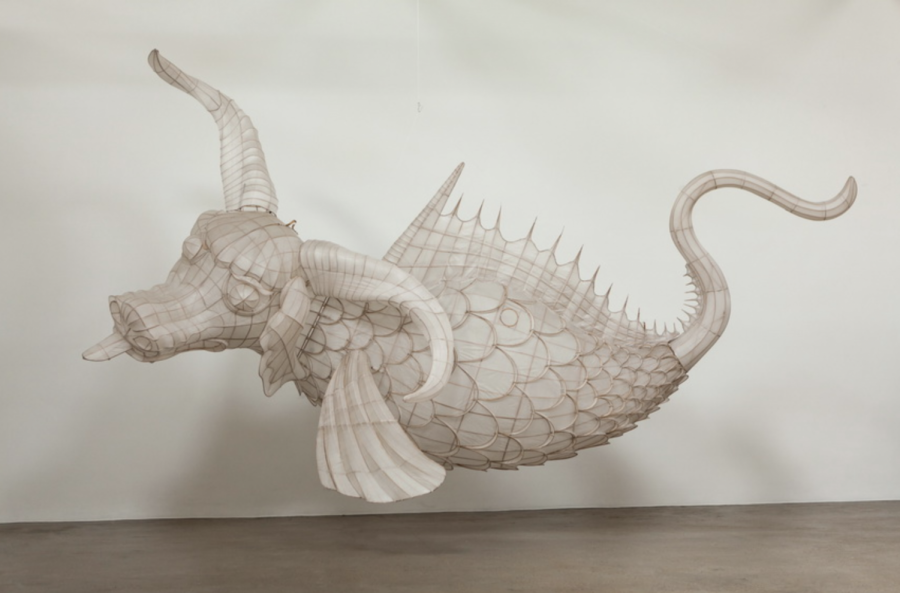Voices Spoken by Contemporary Art
May 13, 2019
After studying contemporary art, Art History students walked into Marciano Art Foundation, visiting the Chinese contemporary artist Ai Weiwei’s first institutional exhibition in Los Angeles. The exhibition contains Ai’s three major installation art pieces: “Sunflower Seeds” (2010), “Spouts” (2015), and his most recent accomplishment — “Life Cycle” (2018). “Sunflower Seeds,” exhibited in the foundation’s Theater Gallery, is composed of 49 tons of individual porcelain replicas of sunflower seeds, smoothly spread over a 19 x 20-meter rectangular field. Each “seed” was handmade by more than 1,600 artisans in Jingdezhen, China, a town known for producing delicate china by traditional procedures. These “seeds” appear to be diverse individuals from a microcosmic perspective, yet they homogenize from the macroscopic view. The sheer number of “sunflower seeds” and the difficulty to identify any individual within it is Ai’s analogy of today’s vast population in China and the resulting social phenomenon of lost identities.
The work also resembles “the propaganda of the Cultural Revolution depicting Mao Zedong as the Red Sun and citizens as the sunflowers turning toward him.” In this way, Ai appeals to democracy in Chinese society. Adjacent to “Sunflower Seeds” is “Spouts.”
As the title suggests, it is a similarly-installed rectangular field piled with thousands of porcelain teapot spouts dating back to the Song Dynasty. Thousands of spouts resemble thousands of mouths yearning for their own voices. Through this metaphor, Ai expresses his longing for freedom of speech. In the Black Box sits the highlight of the exhibition.
“Life Cycle” reveals Ai’s response to the global refugee crisis. The installation contains three components — a boat, suspended mythic creatures hanging from the ceiling, and Ten Windows hanging around the Black Box. Placed at the center of the installation, the boat made of bamboo is the type used by countless refugees to reach Europe. Within the boat are animals of the Chinese zodiac as well as human figures. Ai’s usage of the Chinese zodiac is probably a reappearance of the situation where the animals must pass a river to prove their capability of being honored as the zodiacs, which is similar to the refugees who try to pass the river to settle.
Nefertiti is also found at one end of the boat, which may be Ai’s intention to claim refugee crisis as a social problem throughout all periods and cultures. Suspended around the boat are kite-like creatures crafted from silk and bamboo in Weifang, China, a city known for traditional kite- making skills dating back to the Ming Dynasty. These mythological creatures are based on a Chinese classic mythology text titled “Shanhaijing,” or “Classic of Mountains and Seas.” Along the walls are Ai’s Windows series (2015).
Ten windows are crafted from bamboo with clear shadows on the back wall. These vignettes feature scenes concerning mythological tales, Ai’s biography, as well as homages to other remarkable 20th century conceptual artists, such as Marcel Duchamp.
A major theme throughout the 10 vignettes is Ai’s defense of freedom of speech, demonstrated by depicting his personal experience of being arrested and detained for three months by Chinese government. “This multifaceted installation is a continuation of Ai’s ongoing engagement with politics and social justice,” according to the Marciano Art Foundation. Ai’s use of Chinese traditional craftsmanship, his conceptual creativity, as well as powerful political appeals concerning social freedom and justice mark him an outstanding and influential contemporary artist of our time. Through the exhibition, art history students were able to comprehend Ai Weiwei’s unique life experience and its reflection on his artistic creations. Most importantly, students developed a deeper understanding into the powerful voices spoken by contemporary art and its un- negligible significance in our modern society.

































